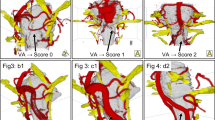Abstract
Detailed knowledge of the vascular anatomy of the anterior skull base is critical to successful surgery in this area. Whereas conventional neuronavigational approaches combine MRI (± contrast) for tumor visualization and CT (± C) for bony and vascular anatomy, we describe the Canadian and Austrian experiences using a novel protocol integrating MR angiography (MRA) into surgical neuronavigation to provide superior visualization of the carotid arteries. The pre-operative imaging protocol employs a T1-weighted, 3D fast spoiled gradient echo MRI (± C) for soft tissue anatomy, a plain CT for bony anatomy, and a 3D time-of-flight MR angiography for carotid anatomy. The series are imported into the Medtronic StealthStation® TREON® Treatment Guidance System; during intra-operative neuronavigation, each series (MRI, CT, MRA) can be viewed individually, or layered and viewed as a composite image. Our protocol has important advantages. First, it provides detailed tissue, tumor, vascular and bony anatomy. Second, a contrast CT is not necessary; this is important, as numerous reports have highlighted the nephrotoxic nature of radiographic contrast material. Third, visualization of the carotid system is superior than can be obtained from CT angiography. We use this unique imaging protocol routinely for our endoscopic transsphenoidal surgeries to provide superior visualization of the carotid arteries during anterior skull base surgery.






Similar content being viewed by others
References
Guiot G, Thibaut B (1959) L’extirpation des adenomas hypophysaires par voie trans-sphenoidale. Neurochirurgia (Stuttg) 1:133–150
Hardy J (1969) Transsphenoidal microsurgery of the normal and pathological pituitary. Clin Neurosurg 16:185–217
Hardy J (1971) Transsphenoidal hypophysectomy. J Neurosurg 34:582–594
Hardy J, Wigser SM (1965) Transsphenoidal surgery of the pituitary fossa tumors with televised radiofluoroscopic control. J Neurosurg 23:612–619
Black PM, Zervas N, Candia GL (1987) Incidence and management of complications of transsphenoidal operation for pituitary adenomas. Neurosurgery 20:920–924
Barker FG, Klibanski A, Swearingen B (2003) Transsphenoidal surgery for pituitary tumors in the United States, 1996–2000: mortality, morbidity, and the effects of hospital and surgeon volume. J Clin Endocrinol Metabol 88:4709–4719
Senior BA, Ebert CS, Bednarski KK, Bassim MK, Younes M, Sigounas D, Ewend MG (2008) Minimally invasive pituitary surgery. Laryngoscope 118:1842–1855
Couldwell WT, Weiss MH, Rabb C, Liu JK, Apfelbaum RI, Fukushima T (2004) Variations on the standard transsphenoidal approach to the sellar region, with emphasis on the extended approaches and parasellar approaches: surgical experience in 105 cases. Neurosurgery 55:539–547
de Divitiis E, Cappabianca P, Cavallo LM (2002) Endoscopic transsphenoidal approach: adaptability of the procedure to different sellar lesions. Neurosurgery 51:699–705
Cappabianca P, Briganti F, Cavallo LM, de Divitiis E (2001) Pseudoaneurysm of the intracavernous carotid artery following endoscopic endonasal transsphenoidal surgery, treated by endovascular approach. Acta Neurochir (Wien) 143:95–96
Kassam A, Snyderman CH, Carrau RL, Gardner P, Mintz A (2005) Endoneurosurgical hemostasis techniques: lessons learned from 400 cases. Neurosurg Focus 19:E7
Knosp E, Steiner E, Kitz K, Matula C (1993) Pituitary adenomas with invasion of the cavernous sinus space: a magnetic resonance imaging classification compared with surgical findings. Neurosurgery 33:610–617
Bedford MA (1966) The “cavernous” sinus. Br J Ophthal 50:41–46
Bull JWD, Schunk H (1962) The significance of displacement of the cavernous portion of the internal carotid artery. Br J Radiol 35:801–814
Nash K, Hafeez A, Hou S (2002) Hospital-acquired renal insufficiency. Am J Kidney Dis 39:930–936
Gleeson TG, Bulugahapitiya S (2004) Contrast-induced nephropathy. AJR 183:1673–1689
Hou SH, Bushinsky DA, Wish JB, Cohen JJ, Harrington JT (1983) Hospital-acquired renal insufficiency: a prospective study. Am J Med 74:243–248
Newhouse JH, Kho D, Rao QA, Starren J (2008) Frequency of serum creatinine changes in the absence of iodinated contrast material: implications for studies of contrast nephrotoxicity. AJR Am J Roentgenol 191:376–382
Willinsky RA, Taylor SM, TerBrugge K, Farb RI, Tomlinson G, Montanera W (2003) Neurologic complications of cerebral angiography: prospective analysis of 2,899 procedures and review of the literature. Radiology 227:522–528
Acknowledgments
The authors would like to thank Carla Roberts for her assistance in the preparation of this manuscript.
Author information
Authors and Affiliations
Corresponding author
Rights and permissions
About this article
Cite this article
McGrath, B.M., Maloney, W.J., Wolfsberger, S. et al. Carotid artery visualization during anterior skull base surgery: a novel protocol for neuronavigation. Pituitary 13, 215–222 (2010). https://doi.org/10.1007/s11102-010-0220-0
Published:
Issue Date:
DOI: https://doi.org/10.1007/s11102-010-0220-0




